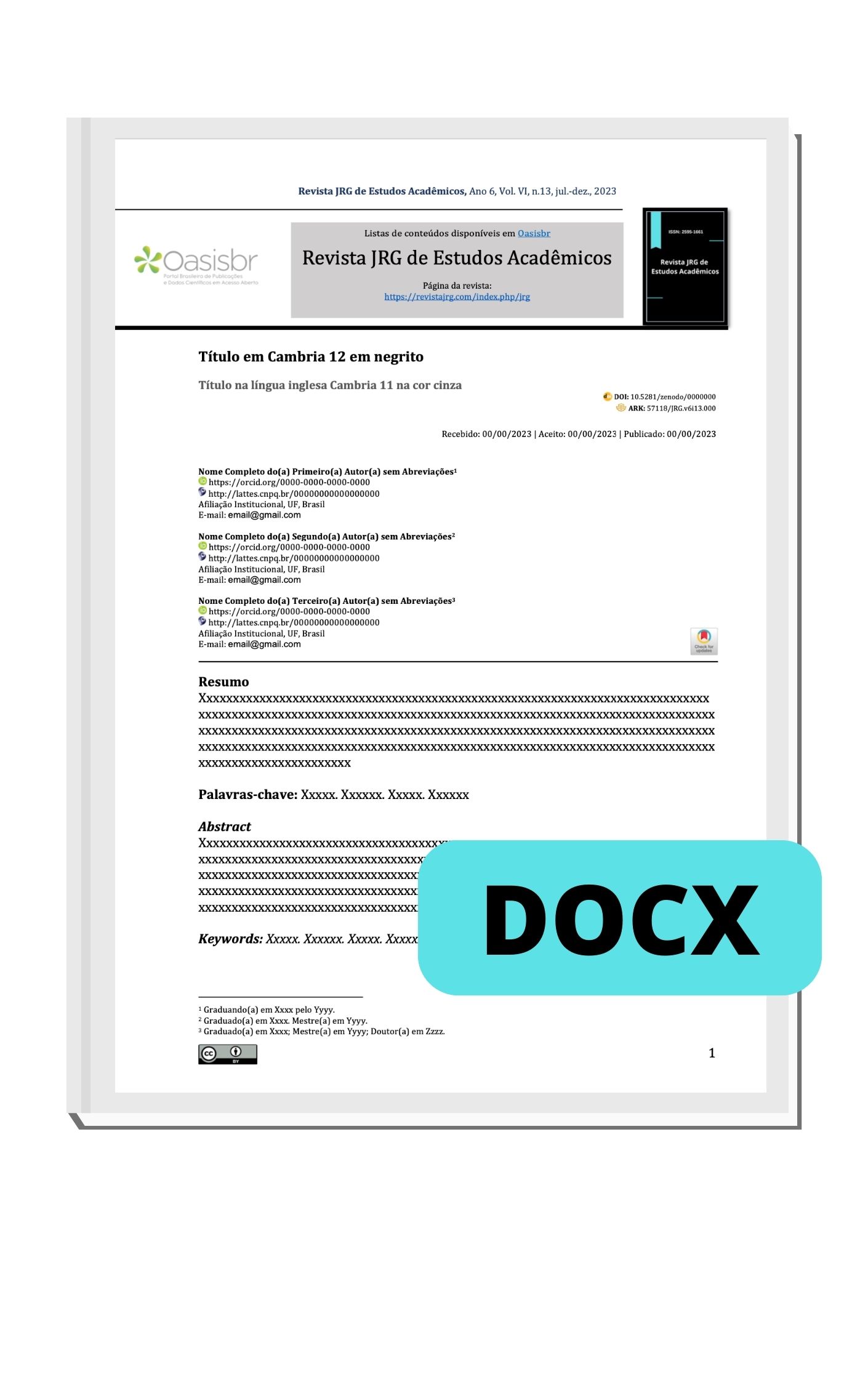Sociodemographic and clinical profile of patients hospitalized for Covid-19 in a teaching hospital
DOI:
https://doi.org/10.55892/jrg.v8i19.2354Keywords:
Covid-19, SARS-CoV-2, Descriptive epidemiology, Socioeconomic factors, Demographic factorsAbstract
The need to expand knowledge about the relationship between the sociodemographic and clinical profile of patients is evident, considering the severity of the disease and unique aspects of care. The objective of this study was to identify the sociodemographic and clinical profile of patients hospitalized for covid-19 in a teaching hospital. This is a documentary, retrospective, quantitative study, carried out based on the analysis of 153 physical medical records of patients hospitalized for covid-19 between March 2020 and March 2022. Data analysis was carried out using an exploratory method, with a time lapse of the bibliography of the last five years. There was a predominance of females (82) (53.59%), age group 30 to 39 years (36) (23.53%), brown race (84) (54.90%), single marital status (63) (41.18%), and high school diploma (41) (26.80%). The most frequent occupations were self-employed, bricklayer, and fisherman (34, 22.22%), followed by retirees (18, 11.54%), and those with incomes up to 1 minimum wage (6, 3.90%). Most patients came from hospitals or emergency care units in the capital (83, 54.25%). The most frequent comorbidities were systemic arterial hypertension (58, 26.73%) and diabetes mellitus (37, 17.05%). Mild cases of covid-19 accounted for the majority (81, 52.94%), followed by severe cases (19, 12.42%). It is concluded that the study contributed to assessing the sociodemographic and clinical profile of covid-19 patients in the hospital setting, potentially guiding and qualifying patient care.
Downloads
References
AGÊNCIA NACIONAL DE VIGILÂNCIA SANITÁRIA – ANVISA. Nota técnica GVIMS/GGTES/ANVISA n.º 06/2020: orientações para a prevenção e o controle das infecções pelo novo Coronavírus (SARS‑CoV‑2) em procedimentos cirúrgicos. Brasília, 2020. Disponível em: https://bibliotecadigital.anvisa.gov.br/jspui/bitstream/anvisa/364/3/NOTATECNICA_06_2020_GVIMS_GES_ANVISA_29.04.2020_orienta%c3%a7%c3%b5esparaapreven%c3%a7%c3%a3oeocontroledasinfec%c3%a7%c3%b5espelonovocoronav%c3%adrus%28SARS-CoV-2%29emprocedimentoscir%c3%bargicos.pdf. Acesso em: 15 fev. 2024.
ALMEIDA, N. H. F. et al. Perfil sociodemográfico e clínico de pacientes com COVID-19 que foram a óbito em Unidade de Terapia Intensiva. Revista Eletrônica Acervo Saúde, v. 24, n. 6, p. e16385-e16385, 2024. Disponível: https://doi.org/10.25248/reas.e16385.2024. Acesso em: 20 jun. 2024.
ALMEIDA‑PITITTO, B. et al. Severity and mortality of COVID‑19 in patients with diabetes, hypertension and cardiovascular disease: a meta‑analysis. Diabetology & Metabolic Syndrome, 2020. Disponível: https://doi.org/10.1186/s13098-020-00586-4. Acesso em: 23 jun. 2024.
ALMEIDA, W. S. et al. Mudanças nas condições socioeconômicas e de saúde dos brasileiros durante a pandemia de COVID-19. Revista Brasileira de Epidemiologia, v. 23, p. e200105, 2020. Disponível: https://doi.org/10.1590/1980-549720200105. Acesso em: 17 mai. 2024.
ALVES, B. L. S. et al. Impact of Covid-19 on diabetic adults: systematic review. Journal of Health & Biological Sciences, v. 10, n. 1, p. 1-7, 2022. Disponível: https://doi.org/10.12662/2317-3076jhbs.v10i1.4249.p1-7.2022. Acesso em: 24 abr. 2024.
AKTAR, S. et al. Machine learning and meta‑analysis approach to identify patient comorbidities associated with COVID‑19 mortality. Diagnostics, v. 11, n. 8, p. 1383, 2021. Disponível: https://doi.org/10.3390/diagnostics11081383. Acesso em: 05 ago. 2025.
BAPTISTA, E. A.; QUEIROZ, B. L.; LIMA, E. C. Regional COVID‑19 mortality in Brazil by age. Vienna Yearbook of Population Research, v. 20, p. 349–365, 2022. Disponível: https://austriaca.at/0xc1aa5572%200x003fa4a2.pdf. Acesso em: 07 jun. 2024.
BHALA, N. et al. Sharpening the global focus on ethnicity and race in the time of COVID-19. The Lancet, v. 395, n. 10238, p. 1673-1676, 2020. Disponível: https://www.thelancet.com/journals/lancet/article/PIIS0140-6736(2031102-8/fulltext. Acesso em: 05 fev. 2024.
BRASIL. Ministério da Saúde. Secretaria de Vigilância em Saúde. Boletim epidemiológico especial: COE - Covid-19. Brasília, DF: Ministério da Saúde, 2021. Disponível: https://www.gov.br/saude/pt-br/centrais-de-conteudo/publicacoes/boletins/epidemiologicos/covid-19/2020/boletim-epidemiologico-no-14-boletim-coe-coronavirus/view. Acesso em: 19 mar. 2024.
BRASIL. Ministério da Saúde. Secretaria de Vigilância em Saúde. Boletim epidemiológico especial: doença pelo Coronavírus – Covid-19, nº 30. Brasília, DF: Ministério da Saúde, 2020. Disponível: https://www.saude.gov.br/images/pdf/2020/September/09/Boletim-epidemiologico COVID 30.pdf. Acesso em: 20 mar. 2024.
BRASIL. Instituto Brasileiro de Geografia e Estatística. População residente, por sexo: Brasil — Censo Demográfico 2022. Rio de Janeiro: IBGE, 2023. Disponível: https://www.ibge.gov.br. Acesso em: 17 mai. 2024.
CALDEIRA, D. et al. Angiotensin-converting enzyme inhibitors and angiotensin-receptor blockers and the risk of COVID-19 infection or severe disease: systematic review and meta-analysis. IJC Heart & Vasculature, v. 31, p. 100627, 2020. Disponível: https://doi.org/10.1016/j.ijcha.2020.100627. Acesso em: 15 mar. 2024.
CAMARANO, A. A. Os dependentes da renda dos idosos e o coronavírus: órfãos ou novos pobres?. Ciência e Saúde Coletiva, v. 25, p. 4169–4176, 2020. Disponível: https://doi.org/10.1590/1413-812320202510.2.30042020. Acesso em: 22 mar. 2024.
CENTERS FOR DISEASE CONTROL AND PREVENTION (CDC). Coronavirus disease 2019: cases in the U.S. Atlanta, GA: CDC, 2020. Disponível em: https://www.cdc.gov/coronavirus/2019-ncov/cases-updates/cases-in-us.html. Acesso em: 18 abril. 2024.
CENTERS FOR DISEASE CONTROL AND PREVENTION (CDC). Underlying conditions and the higher risk for severe COVID‑19. Atlanta, GA: CDC, maio de 2025. Disponível em: https://www.cdc.gov/covid/hcp/clinical-care/underlying-conditions.html. Acesso em: 05 ago. 2025.
CHEN, N. et al. Epidemiological and clinical characteristics of 99 cases of 2019 novel coronavirus pneumonia in Wuhan, China: a descriptive study. Lancet, v. 395, n. 10223, p. 507-513, 2020. Disponível: https://doi.org/10.1016/s0140-6736(20)30211-7. Acesso em: 12 mar. 2024.
CHENG, V. C. C.; SHAN, H. Y. Changing age distribution of the COVID-19 pandemic. Journal of Clinical Microbiology, v. 58, n. 9, p. e01309-20, 2020. Disponível: https://doi.org/10.1128/JCM.01309-20. Acesso em: 05 jun. 2024.
CORRÊA, T. D. et al. Características clínicas e desfechos de pacientes com COVID-19 admitidos em unidade de terapia intensiva durante o primeiro ano de pandemia no Brasil: um estudo de coorte retrospectivo em centro único. Einstein (São Paulo), v. 19, p. eAO6739, 2021. Disponível: https://doi.org/10.31744/einstein_journal/2021AO6739. Acesso em: 16 mar. 2024.
CRODA, J. et al. COVID-19 in Brazil: advantages of a socialized unified health system and preparation to contain cases. Revista da Sociedade Brasileira de Medicina Tropical, v. 53, p. e20200167, 2020. Disponível: https://doi.org/10.1590/0037-8682-0167-2020. Acesso em: 24 abr. 2024.
GOUVEIA, G. P. M. et al. Incidência e letalidade da covid-19 no Ceará, 2020. Cadernos ESP, v. 14, n. 1, p. 10–16, 2020. Disponível: https://cadernos.esp.ce.gov.br/index.php/cadernos/article/view/326. Acesso em: 24 jun. 2024.
LIANG, W. et al. Cancer patients in SARS-CoV-2 infection: a nationwide analysis in China.The Lancet Oncology, v. 21, n. 3, p. 335-337, 2020. Disponível: https://doi.org/10.1016/s1470-2045(20)30096-6. Acesso em: 27 jun. 2024.
MARQUES, L. C. et al. COVID-19: nursing care for safety in the mobile pre-hospital service. Texto e Contexto - Enfermagem, v. 29, p. e20200119, 2020. Disponível: https://doi.org/10.1590/1980-265X-TCE-2020-0119. Acesso em: 16 mai. 2024.
ORGANIZAÇÃO MUNDIAL DA SAÚDE (OMS). Report of the WHO–China Joint Mission on Coronavirus Disease 2019 (COVID‑19), 16–24 February 2020. Geneva: World Health Organization, 2020. Disponível: https://www.who.int/docs/default-source/coronaviruse/who-china-joint-mission-on-covid-19-final-report.pdf.Acesso em: 19 mar. 2024.
SANTOS, M. P. A. D. et al. População negra e Covid-19: reflexões sobre racismo e saúde. Estudos Avançados, v. 34, n. 99, p. 225–244, 2020. Disponível: http://dx.doi.org/10.1590/s0103-4014.2020.3499.014. Acesso em: 15 fev. 2024.
WU, Z.; MCGOOGAN, J. M. Characteristics of and important lessons from the coronavirus disease 2019 (COVID-19) outbreak in China: summary of a report of 72 314 cases from the chinese center for disease control and prevention. Jama, v. 323, n. 13, p. 1239-1242, 2020. Disponível: https://doi.org/10.1001/jama.2020.2648. Acesso em: 15 abr. 2024.
ZHENG, Z. et al. Risk factors of critical & mortal COVID-19 cases: a systematic literature review and meta-analysis. Journal of Infection, v. 81, n. 2, p. e16-e25, 2020. Disponível: https://doi.org/10.1016/j.jinf.2020.04.021. Acesso em: jun. 2024.
ZHOU, F. et al. Clinical course and risk factors for mortality of adult inpatients with COVID- 19 in Wuhan, China: a retrospective cohort study. The Lancet, v. 395, n. 10229, p. 1054- 1062, 2020. Disponível: https://doi.org/10.1016/s0140-6736(20)30566-3. Acesso em: 19 abr. 2024.











































